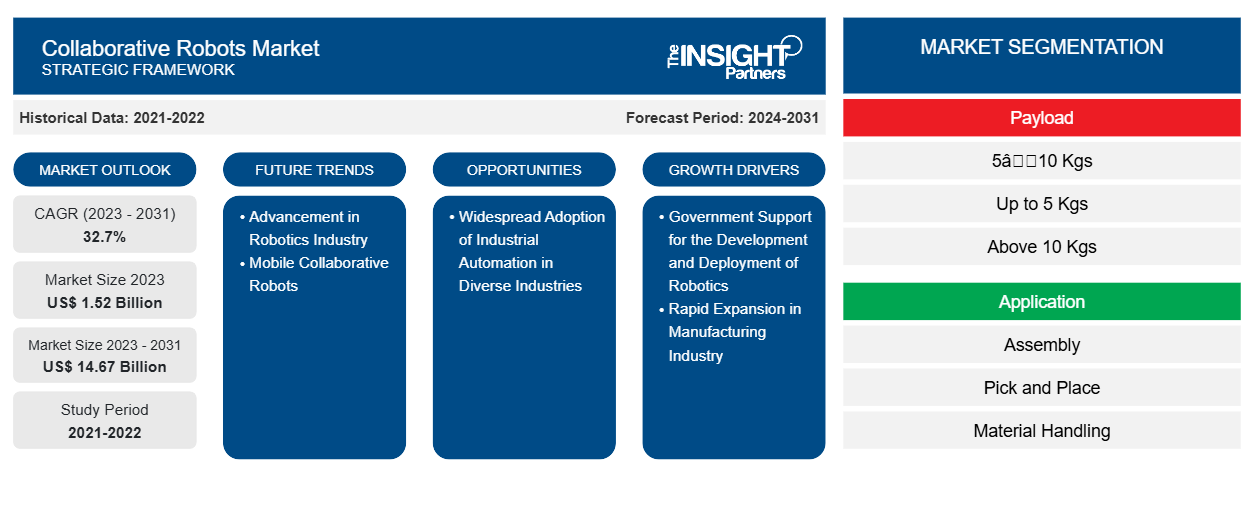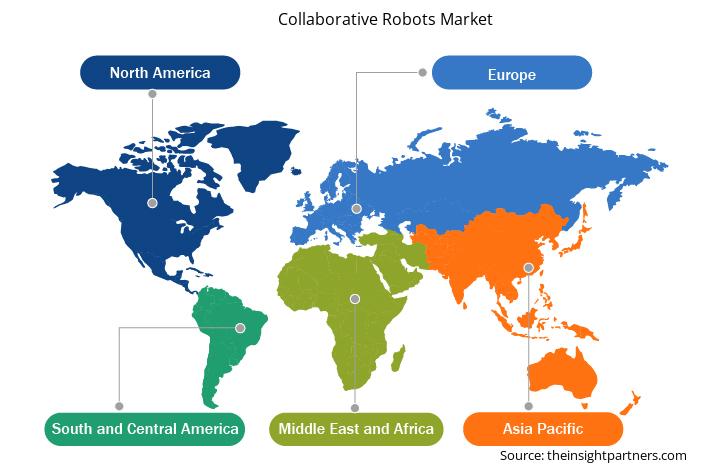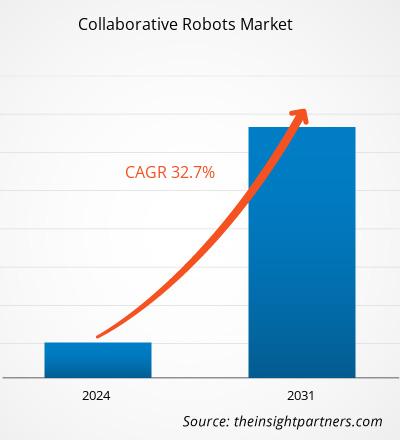协作机器人市场规模预计将从2024年的18.8亿美元增至2031年的146.7亿美元。预计2025年至2031年期间,该市场的复合年增长率将达到35.7%。移动协作机器人有望引领市场新趋势。
协作机器人市场分析
协作机器人是服务机器人的一个分支,用于物料搬运、制造和实验室。工厂对协作机器人的需求不断增长,尤其是在人机协作已开始实现协同工作的制造业领域,这推动了协作机器人市场的增长。协作机器人的出现创造了一个值得信赖的工作环境,使人机能够安全地协同工作。推动市场发展的关键因素包括政府对机器人技术开发和部署的支持,以及制造业的快速扩张。
协作机器人市场概况
工业格局正在经历重大变革,这主要得益于协作机器人的兴起——先进的机器旨在与人类安全有效地协同工作。这些机器人正在进化成为智能的“队友”,增强安全性、提高生产力并支持可持续运营。协作机器人以与人类同等的速度运行,简化了与运动相关的风险评估,使附近的操作员更容易避免意外接触。
全球多个国家的政府正在采取措施,支持和推动机器人技术在各自国家的开发和应用。这些政府举措预计将推动全球工业机器人市场的增长,从而刺激对协作机器人的需求。2022年,欧洲占据了全球协作机器人市场的最大收入份额。在欧洲,强劲的汽车行业和主要高端汽车制造商的加入预计将推动协作机器人市场的发展。此外,电动汽车制造业的增长预计将推动协作机器人市场的增长。
您可以免费定制任何报告,包括本报告的部分内容、国家级分析、Excel 数据包,以及为初创企业和大学提供优惠和折扣
协作机器人市场:战略洞察

-
获取此报告的顶级关键市场趋势。此免费样品将包括数据分析,从市场趋势到估计和预测。
协作机器人市场驱动因素和机遇
政府对机器人技术开发和部署的支持
世界各国政府正在采取措施,支持和推动机器人技术在各自国家的开发和应用。例如,新加坡政府根据其产业转型计划,宣布了多项措施,以促进企业创新、自动化和扩张,并获得融资。印度政府采取了多项措施来推动印度的智能制造,其中包括“生产挂钩激励计划”(PLI)。作为政府促进印度制造业发展的一项重要举措,PLI计划于2020年启动,涵盖了汽车、制药、纺织、食品加工和白色家电等14个行业。此外,中国政府也采取了多项措施,推动工业机器人技术在本国制造业的部署。其中包括旨在发展高科技产业的“中国制造2025”计划。此外,中国政府还宣布了一项为期五年的“机器人产业发展规划”,以扩大中国工业机器人产业。政府正在为工业自动化提供大量补贴和税收减免。此外,德国的“工业4.0”计划也涵盖了工业机器人的开发和部署。政府宣布,将在2016年至2020年期间每年提供约7800万美元的不可退还现金补助,用于支持研究机构、企业和学者开展人机交互研究。目前,政府已提供约300个与自动化和机器人技术相关的学习项目。
韩国政府公布了一项270万美元的投资计划,即《智能机器人发展第二个基本计划(2014-2018)》。第二个基本计划(2014-2018)结束后,政府又制定并实施了第三个智能机器人基本计划(2019-2023)。
制造业快速扩张
近年来,工业格局发生了翻天覆地的变化,协作机器人在推动重大变革方面发挥着主导作用。与传统机器人不同,协作机器人的设计初衷是与人类并肩工作,其编程通常涉及需要人类协作的安全措施,这限制了它们的独立操作。尽管如此,协作机器人在提升工作场所安全性的同时,还能显著提高生产力,实现更灵活、更经济高效的运营。它们已成为现代工业的重要组成部分,其应用范围已从制造业扩展到全球的物流和医疗保健领域。
在制造业领域,协作机器人广泛应用于装配、焊接、机器操作以及包装或码垛任务。它们能够执行重复性和精确的操作,从而提高产品质量并减少员工疲劳。通过自动化日常任务,协作机器人使人类工人能够专注于更高价值的活动,最终提高整个制造流程的生产力、效率和工作场所安全性。全球制造业正在快速扩张,新兴地区纷纷投资建设制造工厂。这种扩张促进了技术创新,从而提高工厂生产力,保持客户优势并获得竞争优势。因此,制造业的快速扩张推动了全球对协作机器人的需求。
协作机器人市场报告细分分析
有助于得出协作机器人市场分析的关键部分是有效载荷、应用、类型、最终用户行业和功能。
- 根据有效载荷,市场细分为5-10公斤、5公斤以下和10公斤以上。2024年,5-10公斤级市场占据了最大的市场份额。
- 根据应用,市场可分为装配、拾取和放置、物料搬运、质量测试、机器看管、焊接、包装等。装配领域在2024年占据了最大的市场份额。
- 按类型划分,市场分为机械臂、焊枪、夹持器和其他。机械臂领域在2024年占据了最大的市场份额。
- 按终端用户行业划分,市场细分为汽车、电子、金属和机械、食品和饮料、物流、制药等。2024年,汽车行业占据了市场主导地位。
- 根据功能,市场分为静态机器人和移动机器人。2024年,静态机器人市场占据主导地位。
协作机器人市场份额(按地区)分析
协作机器人市场报告的地理范围主要分为五个地区:北美、亚太、欧洲、中东和非洲、南美和中美。
2024年,亚太地区在协作机器人市场占据了相当大的份额。亚太地区由众多发展中国家组成,其制造业发展迅猛。该地区已成为全球制造业中心,拥有多元化的制造业。在中国转型成为高技能制造业中心的同时,印度、韩国、台湾和越南等新兴经济体也日益吸引着寻求将中低技能制造业业务转移的企业。这些国家/地区拥有极具竞争力的劳动力成本,并通过政府扶持措施积极吸引外国直接投资。然而,为了巩固其作为该地区领先制造业目的地的地位,这些国家/地区必须应对诸如熟练劳动力短缺、生产力水平低下以及基础设施欠发达等挑战。
亚太地区发展中经济体的政府正在提供税收减免、资金、补贴和其他类似支持,以吸引制造企业在各自国家设厂。此外,一些政府还推出了“中国制造2025”和“印度制造”等举措。然而,作为全球最大的制造业中心,中国由于人口老龄化,其劳动力成本正在上升。这促使制造企业寻求在东南亚国家投资。基础设施的改善、国内消费的不断增长以及较低的成本是吸引制造企业前往这些国家的一些因素。
中国是全球最大的乘用车生产国。日本、印度和韩国是亚太地区其他几个主要的汽车制造国。除汽车行业外,中国其他多个行业也在部署协作机器人;例如,在中国最大的卫浴配件制造商之一厦门润纳实业有限公司,其生产线上部署了64台优傲机器人,用于执行从搬运、注塑机到产品组装等各种任务。
协作机器人市场区域洞察
Insight Partners 的分析师已详尽阐述了预测期内影响协作机器人市场的区域趋势和因素。本节还讨论了北美、欧洲、亚太地区、中东和非洲以及南美和中美洲的协作机器人市场细分和地域分布。

- 获取协作机器人市场的区域特定数据
协作机器人市场报告范围
| 报告属性 | 细节 |
|---|---|
| 2025年的市场规模 | 18.8亿美元 |
| 2031年的市场规模 | 146.7亿美元 |
| 全球复合年增长率(2025-2031) | 35.7% |
| 史料 | 2021-2023 |
| 预测期 | 2025-2031 |
| 涵盖的领域 |
按有效载荷
|
| 覆盖地区和国家 |
北美
|
| 市场领导者和主要公司简介 |
|
协作机器人市场参与者密度:了解其对业务动态的影响
协作机器人市场正在快速增长,这得益于终端用户需求的不断增长,而这些需求的驱动因素包括消费者偏好的演变、技术进步以及对产品优势的认知度的提升。随着需求的增长,企业正在扩展产品线,不断创新以满足消费者需求,并抓住新兴趋势,从而进一步推动市场增长。
市场参与者密度是指特定市场或行业内企业或公司的分布情况。它表明特定市场空间内竞争对手(市场参与者)的数量相对于其规模或总市值而言。
协作机器人市场的主要公司有:
- 库卡股份公司
- 安川美国公司
- 遨博(北京)机器人科技有限公司
- 斗山机器人公司
- 发那科公司
- ABB有限公司
免责声明:以上列出的公司没有按照任何特定顺序排列。

- 获取协作机器人市场主要参与者概览
协作机器人市场新闻和最新发展
协作机器人市场评估是通过收集一手和二手研究的定性和定量数据进行的,这些数据包括重要的企业出版物、协会数据和数据库。协作机器人市场的一些发展情况如下:
- 欧姆龙宣布推出欧姆龙 S 系列协作机器人,该系列专为跨行业的各种应用而设计。这些协作机器人采用先进的硬件、更多安全功能和认证以及下一代配置功能,使其比以往任何时候都更易于使用。(来源:欧姆龙,新闻稿,2024 年 9 月)
- 国际领先的独立第三方检测、检验和认证机构德国莱茵TÜV集团向埃斯顿自动化股份有限公司颁发了ESS(ESTUN安全解决方案)产品CE机械指令及功能安全符合性证书。这标志着埃斯顿在构建完善的机器人功能安全产品体系方面取得了长足进步。此次认证不仅彰显了埃斯顿在机器人技术领域的创新实力和专业水平,更体现了其对产品安全和质量的严格把控和承诺,并将进一步提升埃斯顿在全球市场的服务质量和效率。(来源:ESTUN Robotics,新闻稿,2024年4月)
协作机器人市场报告覆盖范围和交付成果
《协作机器人市场规模和预测(2021-2031)》报告对以下领域进行了详细的市场分析:
- 协作机器人市场规模以及涵盖范围内所有关键细分市场的全球、区域和国家层面的预测
- 协作机器人市场趋势以及驱动因素、限制因素和关键机遇等市场动态
- 详细的 PEST 和 SWOT 分析
- 协作机器人市场分析涵盖主要市场趋势、全球和区域框架、主要参与者、法规和最新市场发展
- 行业格局和竞争分析,涵盖市场集中度、热图分析、知名参与者以及协作机器人市场的最新发展
- 详细的公司简介
- 历史分析(2 年)、基准年、预测(7 年)及复合年增长率
- PEST和SWOT分析
- 市场规模、价值/数量 - 全球、区域、国家
- 行业和竞争格局
- Excel 数据集
近期报告
客户评价
购买理由
- 明智的决策
- 了解市场动态
- 竞争分析
- 客户洞察
- 市场预测
- 风险规避
- 战略规划
- 投资论证
- 识别新兴市场
- 优化营销策略
- 提升运营效率
- 顺应监管趋势






















 获取免费样品 - 协作机器人市场
获取免费样品 - 协作机器人市场